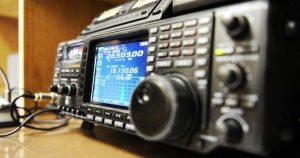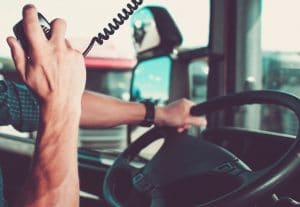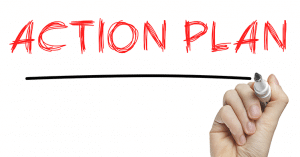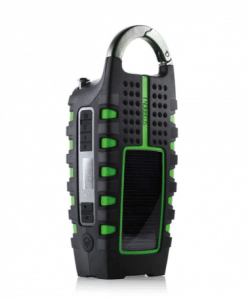You need an SHTF radio if you want to be prepared for any disaster. We will explain why you will need a good antenna that can receive frequency signals from far. Remember, you will need a license if you want to broadcast. We will help you consider different options and make decisions, such as whether you want to use the radio in your vehicle. Read more about this way of communication, and the next thing you’ll do is probably getting an amateur (ham) radio.
True preppers do not wait for the problems to stockpile — they prevent them from happening. And SHTF communication is a major part of an overall preppers’ strategy for various cataclysmic situations. For those of our readers wondering what on earth SHTF communication stands for, here is a bit of backstory.
It is wrong to think this SHTF is just another zoomers’ slang word as the expression itself traces back to the 1930s at a minimum. Shit hitting the fan refers to the unexpected consequences of something turning out not so good. In contrast, originally, the fan in this expression meant an agricultural mucker, which is generally an enormous machine that sprays fertilizers everywhere on his way.
As SHTF communication associated with doomsday preppers and survivalists is claimed by those as “rather important for survival,” let’s find out what the actual SHTF options are.
Obviously, getting ready for SHTF requires more actions than just stockpiling food or storing water.
And knowing how to send and receive current updates, essential news, alarms, and other information among the thundering chaos will put you in the vanguard of survivalists.
Even if you are literally cut off and left “in the dark,” it does not mean your SHTF communicative devices will be too. So, having a guaranteed means of communicating with others is not only an advantage but almost a preppers’ duty.
Before deciding on the most suitable method for SHTF communications, let’s consider several existing choices separately.
Communication During a Disaster

There is hardly a person who can go without a cell phone for more than a day. Making calls and sending messages has become an intrinsic part of our daily lives. And it would be more satisfying to know that today’s cell phones are designed to assist you even during limited-term emergency situations. For instance, the notification system when in a car accident or automatic call for medical help when having a heart attack, quick navigation tools when you are lost, and so on. Consider using ham radio as well for survival purpose.
However, imagining a cell phone working throughout a massive disaster is much harder — sometimes, it’s impossible even to make a phone call if the network is blocked, damaged, or overloaded. Or, more likely, making outgoing calls and receiving incoming ones is hard when it’s a long power outage, and your cell phone is barely holding a charge. Local networks are often busy during mass events, like a football match or other mass gatherings. The signals interfere, the system is jammed, and communication turns into a struggle. Along with the increasing invasion of cell phones, such network congestions will predictably happen more and more often. We are not implicitly promoting technophobia here now. We mean that practically, learning smoke signaling will be of greater use than relying on cell phones when SHTF.
The sure excusing thing for cell phones in such a case is the ability to exchange text messages. When a massive accident occurs, and cell towers are stuck, try using text as it is slightly less affected by emergencies.
During the infamous Hurricane Katrina, text messages (albeit not instant messages) continued to get through, while in the wilderness, phone signals were unstable and interrupting. Still, texting is at least worth a try.
How about a cell phone signal booster, you may ask. If there is anything left to boost after a massive outage has happened, you may deal with it but counting solely on cell phones as the means of survival communication is downright unwise.
There is a more survivalist-oriented option, though. Consider satellite phones — they connect to the telephone network with the help of radio signals using orbiting satellites instead of terrestrial cell sites utilized by cellphones. Therefore, you will be no longer tied to cell towers-covered areas and will use them anywhere in the world — from the Sahara sands to Arctic tundras.
How About Hand Held Walkie Talkie Radio?

Walkie-talkies, which are not that other as FRS radios (Family Radio Service) or GMRS (General Mobile Radio Service) radios, are suitable for a temporary SHTF case. However, fitting best for a restricted number of people like your family or your survival coalition, GMRS radios (as well as FRS) is not a real crutch if we mean long-distance communication or connecting a multitude of humans.
Still, GMRS / FRS work well when, as we have seen in the movies, a family tries to keep in touch while stalking in some post-disaster surroundings exploring the location.
Surely, the reliability of such a connection hinges on the manufacturing company, the model, and the price rate of your walkie-talkie. So we suppose you should do some field testing of their power and range restrictions before adding them to your shopping cart.
Note: many specified ranges are meant for flat open land territories.
That leads us to the fact the resulting distance range is decreased if there are hills, trees, or tall buildings. This is a crucial nuance to consider when buying a local SHTF communication tool.
Imagine the following situation: a disaster situation occurs, so each family in your neighborhood takes their walkie-talkies working on similar frequencies (provided the given walkie-talkies’ radiofrequency is traditionally limited) so that the signals interfere, everyone is listening in, and much confusion is going on. Thus, it is preferable to estimate its users’ potential and measure your area’s population density in advance.
Now let’s proceed to walkie-talkies’ drawbacks because there are some to take into consideration. Walkie-talkies are a nice choice for local distance communication. What do we mean by saying “local distances”? There is hardly an example of it that can extend to over 200 miles in the distance… The average field-testing usually results in five to seven miles out of a set of well-known models of walkie talkies. To upgrade and increase the distance for at least over 50 miles, one will need a high powered repeater or a set of them. Apparently, such repeaters may hit you in the pocket as they cost thousands of dollars, and you maximize the effect you need to find a high place to install them — the higher, the better.
Summing it up, walkie-talkies are a great option meant for only local communication in a restricted family circle or within a small survival coalition.
Is Ham Radio, Or Amateur Radio, A Good Means Of SHTF Communications?

Ham radio has taken its honorable place among the most popular large-distance communication tools in the middle of the 20th century.
Nevertheless, as telephone networks rapidly evolved, the cost of long-range and international calls became cheaper, so that the mass popularity of radio amateurs began to decline gradually.
What’s still good news for preppers, though, is that ham survival radio is still an asset for survival goals and emergency communications. Why is it so?
- Ham radio networks are time-tested, reliable, and capable of transmitting signals over long distances (their radio wave spectrum ranges from 0.04 inches to over 60 miles);
- They are absolutely independent of cell phone towers;
- To acquire, use, and listen to amateur radio, obtaining a license is not obligatory, which allows us to place it among the advantageous emergency communication methods suitable for most emergency situations.
Among the potential drawbacks, though, there may be the overall cost of ham radio plus the required equipment, small training, and a license. Getting an official license is compulsory only in case you plan to broadcast your own messages. So, to run and promote your ham survival radio equipment legally, an operator needs to acquire a radio license after taking a small test and paying a certain fee.
So, consider the necessary instructions and regulations before becoming an SHTF radio amateur. Does it sound inspiring? Then do not let some set up expenses and a bit of learning prevent you from becoming an official operator with a ham radio license. Ham radio operation is no rocket science, and it will keep you more prepared for an emergency situation. Not mentioning how exciting it would be for the whole family in daily life to find a ham group, seek and catch other amateur radio channels and communicate with each other, exchanging these “almost secret” messages.
It is also worth investing in upgrading your ham radio’s antenna so that you can send and get messages over much longer distances, such as hundreds of miles across the U.S.
Getting intelligence reports and important messages from neighboring states can be very useful in case the power grid in the country is shut down because of an EMP attack. Besides, you will have constant access to global emergency frequencies, the privilege of talking to your local emergency services, and getting the emergency broadcast updates as Ham radios own a particular universally-accepted channel for any emergency transmission called the VHF Channel 16. Browse through existing radio frequency lists to expand existing channels’ ideas and find out the actual disaster preparedness frequency.
Is CB Radio a Viable SHTF Communications Option?

In the good old days, CB Radios or Citizens Band Radios used to be among the most common means of keeping in touch during the 1970s and 80s. As a personal amateur radio service, CB radios were meant to be a two-way radio voice communication system applicable for personal and business activities.
Apparently, by the beginning of the 21st century, such type of radio communication has lost its fame. Well, it probably shouldn’t have. Among CB Radio’s assets were its convenience and greater range signal capacity compared to walkie talkies. Besides, there was neither a license nor education&testing required for its use, contrary to ham radio operation. Airwaves were flying freely, and CB radio operators using all 40 channels and frequencies with no certificate (except Channel 9, which was used only for emergency communications and for travelers’ support). What’s important for today’s survivalists is that Channel 9 still exists; it responds to emergency goals and is still monitored by local and state police, but is not really in demand and far less popular than, for instance, Channel 19, the special Trucker/Road CB radio channel.

Back then, CB radios were not spotless devices, though: firstly, a CB radio was mainly located in a single place within a property, in plus, inside a certain location, the signal efficiency of CB radios depended on surrounding buildings and other interfering objects.
Should I Invest in Listen-Only Radio Devices?
Back to the emergency topic, the most common problem is a power outage, and many of today’s devices do depend on electricity and battery power to run. It means a true prepper always has a B plan — a stable backup power system to launch when SHTF in the long run.
And investing in a listen-only survival radio device is a fine part of the plan. Firstly, they will not hurt your budget as their cost is relatively low. You can also acquire an item with a hand crank to keep it always working — simply twist it and listen and stay informed about the current updates in the event of a disaster. Such shortwave listen-only radios are designed to let you know if any SHTF situation happens.
The second listen-only choice worth mentioning is a police scanner. Compared to the above-mentioned devices, they generally have more restricted options. Still, they will surely provide you with official and life-saving info from state police forces on any SHTF occasion. This choice is not new and already losing some of its popularity given that more and more state organizations are moving to digital technologies.
However, it is an exclusive device since it broadcasts the news over analog police frequencies. So, even though it may become less popular, it is still a trustworthy device transmitting 100% valid and adequate information for emergency use.
Keep in mind that your device should be programmed with a scanner in advance. So we advise you to spend some time tuning it into the right channels to receive proper news and updates from a relevant source.

Your Personal SHTF Communications Action Plan
As technologies evolve and progress over time, radio communications are still there, and they surely will be. From the whole article, we have sorted out the three core aspects of emergency communications and the overall SHTF action plan: Listen, Local, and Long. These three communication levels are the three-pronged attitudes to consider when choosing an emergency radio.
1 – Listen Only Radio

Remember the above-mentioned hand crank survival radio? Consider the one powered with crank and solar energy, portable, convenient, and easy to use wherever you are and whatever the surroundings. Now it’s time to weigh all the pros and cons of such a radio receiver and make a choice.
Here’s the one our team, recommends.
Its compact size, simple design, and no need for batteries make it absolutely hassle-free to use and take into your Bug Out Bag. Besides, this Eton model of Weather Radio is supplied by a tactical flashlight, which makes it a nice combination for off-the-grid scenarios.
If you already have an electrical listen-only connection device for SHTF, you are more independent of this SHTF. Congratulations.
2 – Local Communication
We kindly advise you to get to know what the local survival coalition is and shape your own one. The notion of local communication implies that every participant has walkie-talkies and knows how to operate them efficiently.
Already have it? Now your survival coalition is upgraded to quicker and more advanced-level SHTF communication.
3 – Long-Distance Signal Communication
Becoming a part of amateur radio operators is a challenging but not that complicated opportunity. Amateur radio will grant you the multi-ability — to listen, receive and transmit messages both locally and over long distances, which is crucial to your long-range survival. Ham radio operators knowing the Morse code, gain a qualitatively new level of survival awareness. This knowledge will allow you to transmit signals over Europe on low power, sometimes less than five watts, and more.
Seems all too complicated, and still not sure how to get started? Here is a fine two-way radio to get you started, the Baofeng UV–5R. Click on the following link to find out more about getting a license before legally operating a radio service. After only a few months of learning, you will master the art of long-distance communication with preppers, survivalists, and other radio amateurs all over the world!
The earlier you build your SHTF action strategy, the sooner you make a difference in your survival and others’ awareness.
Another crucial tip from us: getting thoroughly acquainted with radiofrequency lists is also an essential part of your SHTF survival knowledge (for instance, 121.50 is owned by the International aeronautical emergency frequency, 138.225 is the Disaster relief operations frequency, Channel 3 (462.6125 MHz) is one of the Primary Patriot radio channels, and so on), so make sure you take notes of them and always keep radio frequency lists at hand, or pin it to the wall.
Remember: To prepare is already half a deal, to adapt and overcome — almost the other. No one is fully prepared without a proper emergency communications strategy.
FAQs
What is the best type of radio for survival?
If you seek a long-range communication option at a reasonable price, Ham radio is a better option than a walkie-talkie. We recommend two-way radio with a sturdy build quality that has several charging options — try TERA TR-505 GMRS/MURS, compact BaoFeng UV-5R, or any other proven model from Amazon.com or other related sites.
Will a CB radio work after an EMP?
Both CB radio and Ham radio models will still keep going after an EMP happens, as well as walkie-talkies. It’s only a primary step, though, as your batteries will not last long, so think of an overall emergency communications strategy in advance.
Do ham radios work without electricity?
Not always, but they can. As for Ham radio, broadcasting a signal requires a power source. There are ham radio transceivers (transmitting and receiving signals) requiring alternative power sources such as batteries, solar, hand crank generator. During a long-range outage, they are good survivalists’ companions.
Is BaoFeng a good radio?
BaoFeng UV-5R is a stable and economic model with a good reputation, covering a wide range of channels and frequencies. To upgrade it, equip it with chirp software popular for programming amateur radios in multiple formats and data sources with a user-friendly interface compatible with all PCs. We still recommend looking through the reviews to make your own choice.


